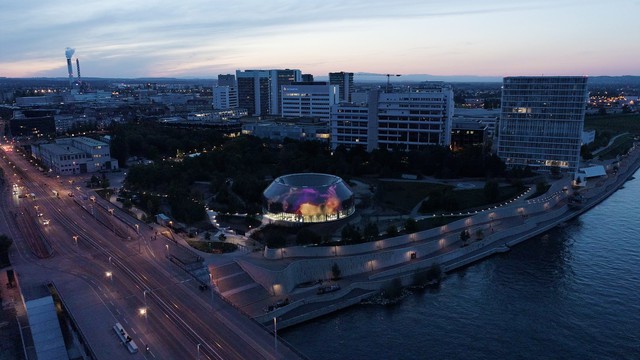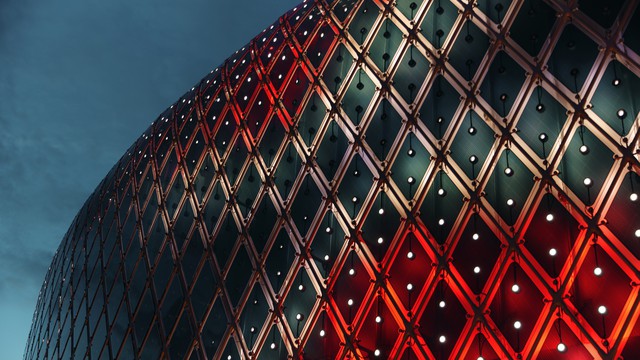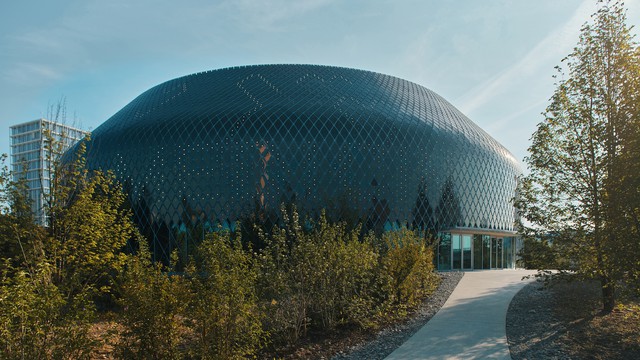Novartis Pavillon 2022, Switzerland, Basel
Zero-energy media facade






The zero-energy media facade of the Novartis Pavillon combines organic photovoltaics and LEDs to create a communicative building skin. It features a total of 10,000 solar modules with 30,000 embedded LEDs and consumes only as much power as it can produce. This visually multi-layered membrane is used to screen the works of three international artists. The Novartis Pavillon is located in Basel, Switzerland, and is a place of learning and exchange, to bring the world of science and medicine closer to the community.
Where sunlight becomes art: The zero-energy media facade of the Novartis Pavillon combines organic photovoltaics and LEDs to create a communicative skin. It features a total of 10’000 solar modules with 30’000 embedded LEDs and consumes only as much power as it can produce. The LEDs shine both outwards and in the direction of the metal shell beneath – causing their light to reflect and shimmer through the semi-transparent solar modules. This visually multi-layered membrane is used to screen the works of three international artists, who collaborated with scientists from Novartis to develop artworks inspired by the shapes and colours of cells and molecules, as well as the themes of sustainability and the convergence of art and science. Every day after sunset, their works are shown on the facade, while during the day, the facade displays moving text. The zero-energy media facade becomes a communicative skin that acts as an interface between inside and outside, the company and the city, bringing the world of science and medicine closer to the community. It turns the Novartis Pavillon into a luminous icon that is visible from many locations in Basel. The Novartis Pavillon is located within a park on the Novartis Campus. It is designed as a place of encounter and learning about life sciences, hosting “Wonders of Medicine”, a permanent multimedia exhibition, as well as meeting spaces and a café.
Details
Building or project owner : Novartis
Architecture : AMDL CIRCLE and Michele De Lucchi
Project artist/ concept/ design/ planning : iart - studio for media architectures
Structural engineering : form TL
Facade design : iart - studio for media architectures / AMDL CIRCLE and Michele De Lucchi
Facade construction : iart – studio for media architectures
Light design : iart – studio for media architectures
Technical layout light : iart – studio for media architectures
Display content/ visuals/ showreel : Daniel Canogar, Esther Hunziker, Semiconductor, curated by HEK (House of Electronic Arts)
Light hardware (LED hardware) : iart – studio for media architectures
Lighting control software : iart AEPOS, TouchDesigner
Project co-ordination : iart – studio for media architectures
Membrane skin : iart - studio for media architectures
Interaction design/ programming : iart – studio for media architectures
Pixel or other basic module/ elements : ASCA (organic photovoltaic modules)
Descriptions
Facade type and geometry (structure) : The media facade consists of 10,000 diamond-shaped organic solar modules with 30'000 RGBW LEDs. They are mounted on a steel frame, which is attached to the sheet metal facade of the donut-shaped building. The solar modules facing outwards each have two embedded LED units, which are bi-directional in the sense that there is one LED pointing away from the facade and one pointing onto the facade. By combining power generation and light source, we created a zero-energy media facade. This means that the total amount of energy consumed by the facade over a year is (at least) equal to the amount of energy it produces itself.
Kind of light creation : Organic photovoltaics makes it possible to create media facades that meet both aesthetic and ecological requirements. Because they can be manufactured in a variety of shapes and sizes, are flexible, semi-transparent and extremely light sensitive, organic solar modules are ideal for a curved structure. They are also carbon-based, contain much less grey energy than silicon solar modules and are thus a good choice not only from a design point of view, but also from a sustainability perspective. At the Novartis Pavillon, the electricity generated by the organic solar cells is used to illuminate the building. The LEDs shine both outwards and in the direction of the metal shell beneath – causing their light to reflect and shimmer through the semi-transparent solar modules.
Resolution and transmitting behaviour : The total resolution of the facade is 240 x 126 px. Each LED forms one pixel and is controlled individually. Half of the LEDs face away from the building, half face towards the building.
Pixel distance : Pixel distance is approx. 56 cm.
Luminace : To keep both energy consumption and light pollution as low as possible, an algorithm was implemented to ensure that the facade is just bright enough for content to be visible. The luminous intensity is constantly adjusted based on the ambient light. The maximum luminance of the facade is 500 nits. The contrast ratio is dynamic, as the LEDs are bi-directional and controlled independently towards the front and back.
Urban situation : The Novartis Pavillon is located in a park within the Novartis Campus in Basel, Switzerland. It is situated right next to the river Rhine and the bridge "Dreirosenbrücke". The zero-energy media facade acts as an interface between the inside and the outside, allowing the building to enter into a dialogue with the surrounding urban space. It turns the Novartis Pavillon into a luminous icon that is visible from many locations in Basel.
Description of showreel : Every day after sunset, the facade shows the works of three international artists: Daniel Canogar, Esther Hunziker and Semiconductor. They collaborated with scientists to develop artworks inspired by the shapes and colours of cells and molecules, as well as the themes of sustainability and the convergence of art and science. During daytime, the facade displays moving text, using only the white LEDs that face away from the building.
Participatory architecture & urban interaction
Mediacredits
Laurids Jensen
iart - studio for media architectures
Laurids Jensen
iart - studio for media architectures
Laurids Jensen
iart - studio for media architectures
iart - studio for media architectures
iart - studio for media architectures